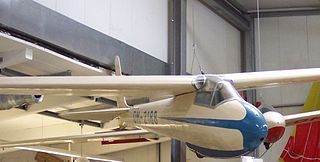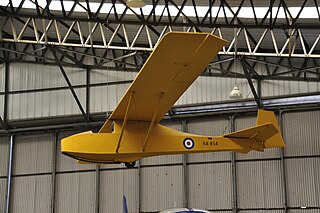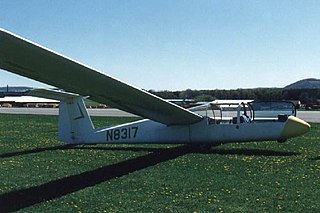
The DFS Olympia Meise was a German sailplane designed by the Deutsche Forschungsanstalt für Segelflug (DFS) for Olympic competition, based on the DFS Meise.

The Slingsby Hengist was a British military glider designed and built by Slingsby Sailplanes Ltd. Like other British troop carrying gliders in the Second World War, it was named after military figures whose name began with H, in this case the Jute invader Hengist.

The Baynes Bat was an experimental glider of the Second World War, designed by L. E. Baynes. It was used to test the tailless design that he had suggested as a means to convert tanks into temporary gliders so they could be flown into battle.

The Aer-Pegaso M-100 was a single-seat glider designed and built in Italy from 1957.

The Schneider Grunau Baby was a single-seat sailplane first built in Germany in 1931, with some 6,000 examples constructed in some 20 countries. It was relatively easy to build from plans, it flew well, and the aircraft was strong enough to handle mild aerobatics and the occasional hard landing. When the Baby first appeared, it was accepted wisdom that the pilot should feel as much unimpeded airflow as possible, to better sense rising and falling currents of air and temperature changes etc.

The Elliots Primary EoN or EoN Type 7 S.G.38 Primary was a training glider built in the UK shortly after World War II. It was an absolutely minimalist aircraft, consisting of a high, cable-braced wing connected to a conventional empennage by an open-truss framework, and was a copy of the German SG 38 Schulgleiter. Marketed to aeroclubs, the Primary EoN was also adopted in 1948 by the Air Training Corps and by the Combined Cadet Force under the name Eton TX.1. An example is at the Gliding Heritage Centre.

The Slingsby T.7 Kirby Cadet is a British training glider designed and built by Slingsby that first flew in 1935 and saw service with the Royal Air Force for use by the Air Training Corps as the Cadet TX.1 throughout the 1950, 1960s and 1970s.

The T.31 Tandem Tutor is a British military training glider, designed and built by Slingsby and used in large numbers by the Air Training Corps between 1951 and 1986.

The Slingsby T.21 is an open-cockpit, side-by-side two-seat glider, built by Slingsby Sailplanes Ltd and first flown in 1944. It was widely used by the Royal Air Force, Sri Lanka Air Force and by civilian gliding clubs.

The Slingsby T.37 Skylark 1 was a small low-cost sailplane built during 1952-3 at Kirbymoorside, Yorkshire by Slingsby Sailplanes.
The PIK-3 was a sailplane produced in Finland in the 1950s and 60s. It was designed to be a cheap and easy-to-build aircraft to equip the country's gliding clubs as their standard single-seat machine. It was a conventional design for its day, with a high wing and conventional empennage. Construction was of wood throughout, skinned in plywood.

The Slingsby T.49 Capstan is a British two-seat glider of the 1960s built by Slingsby Sailplanes as a replacement for their earlier Type 42 Eagle.

The Slingsby T.3 Primary was a single-seat training glider produced in the 1930s by Fred Slingsby in Kirbymoorside, Yorkshire.

The Slingsby T.6/T.23 Kirby Kite was a single-seat sport glider produced from 1935, by Fred Slingsby in Kirbymoorside, Yorkshire.

The Slingsby T.8 Kirby Tutor was a single-seat sport glider produced from 1937, by Fred Slingsby in Kirbymoorside, Yorkshire.

The Eon Olympia was a glider produced from 1947 by Elliotts of Newbury.

The Slingsby T.53 was the first all-metal sailplane designed and built in the United Kingdom. It was designed and built by Slingsby Sailplanes for evaluation by the Royal Air Force.

The Slingsby T.30 Prefect is a 1948 British modernisation of the 1932 single-seat Grunau Baby glider. About 53 were built for civil and military training purposes.

The Slingsby Type 45 Swallow was designed as a club sailplane of reasonable performance and price. One of the most successful of Slingsby's gliders in sales terms, over 100 had been built when production was ended by a 1968 factory fire.

The Schneider DFS 108-14 SG-38 Schulgleiter is a German high-wing, cable-braced, single-seat primary glider that was designed by Schneider, Rehberg and Hofmann at Edmund Schneider's factory at Grunau in 1938, hence the designation. It was produced by several builders, including Deutsche Forschungsanstalt für Segelflug (DFS).



















